This article has multiple issues. Please help improve it or discuss these issues on the talk page . (Learn how and when to remove these template messages)
|


Events in the history of Verona, in Italy.
This article has multiple issues. Please help improve it or discuss these issues on the talk page . (Learn how and when to remove these template messages)
|


Events in the history of Verona, in Italy.
The origins of Verona are unclear.
The relationship between Verona and Ancient Rome was usually one of friendship or alliance. In the 1st century BC the citizens fought alongside the Romans against the Teutones and Cimbri invaders. The city derived importance from possessing the main ford in the area, situated on the Adige river.
Verona became a Roman colony in the year 89 BCE, receiving the franchise in 59 and became a municipium in 49 BCE. The former ford was replaced by two bridges, one of which, the Pothumius Bridge, also functioned as an aqueduct, as well as a dam for setting naval battles in the Theater. The city also had a forum, not far from the current Piazza delle Erbe ( 45°26′36″N10°59′50″E / 45.44333°N 10.99722°E ) and, outside the walls, the famous Arena. Its strategic importance lay in its position at the junction of four main roads: the Via Gallica, from Turin to Aquileia; the Via Claudia Augusta, from Modena to Germany; the Via Postumia, from Liguria to Illyria; and the Vicum Veronensis, which connected the city to Ostiglia.
Due to its leading position in northern Italy, Verona was often involved in civil Roman wars. Famous figures who fought here include Vespasian and Vitellius (CE 69); Philip the Arab and Decius (249); Carinus and Sabinus Julianus (283); and Constantine the Great, who defeated Ruricius Pompeianus here after a long siege in 312. The city was also the residence of emperors on a frequent basis. In 265 the emperor Gallienus, to improve safety, extended the walls to include the Arena.
In the 1st centuries CE, Verona slowly converted to Christianity; sometimes the beliefs of its citizenry aligned closely with unorthodox theories such as those of Arius or Fotinus. Under Bishop St. Zeno, the orthodox doctrine was definitively imposed. (see Ecclesiastical history of Verona )
In 403 the king of the Visigoths, Alaric I, invaded northern Italy from Dalmatia. After setting himself up in Verona, he was defeated by the Roman general Stilicho. In 452 the Hun confederation leader Attila was stopped, after a series of ravages, not far from Verona by an imperial embassy led by Pope Leo I.
After the definitive fall of the Western Roman Empire in 476, Verona was one of the strongholds of Odoacer, whose government was well entrenched in the city. At Verona, Odoacer implemented his last stand against the Ostrogoth army sent against him by the Eastern emperor, which was led by Theodoric the Great.
With the taking of Verona in 489, the Gothic domination of Italy began; Theodoric built one of his palaces in the city: another was in Ravenna. In Germanic legends the name of Verona is linked with that of Theodoric, in German Dietrich von Bern. The city remained in the hands of the Goths all through the Gothic War, with the exception of a single day in 541 when an Armenian officer effected an entrance. The Goths were able to regain possession of the city, due to disagreements which arose among the Byzantine generals with respect to booty. In 552 the Byzantine general Valerian vainly endeavoured to gain an entrance, and only the complete overthrow of the Goths brought about the city's surrender.
In 569 it was taken by Alboin, King of the Lombards. Verona became, for all intents and purposes, the second-most important city of his kingdom. Alboin was killed by his own wife at Verona in 572.
The dukes of Treviso often resided there. At Verona in 774, Adalgisus, son of Desiderius, made his last desperate stand against Charlemagne, who had destroyed the Lombard kingdom. Verona was then the ordinary residence of the kings of Italy. The government of the city became hereditary in the family of Count Milo, progenitor of the counts of San Bonifacio. From 880 to 951 the two Berengarii resided there: Berengar II made the city the seat of a frontier March, which replaced the March of Friuli. At various times, the March of Verona was under the control of the Duchy of Carinthia and at other times not. From 951 to 975, both Carinthia and Verona were under the control of the Duchy of Bavaria.
The 983 royal election was held in Verona.
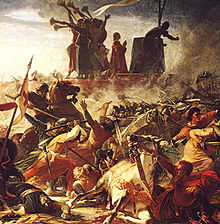
Medieval Verona was dominated by its forty-eight towers. The increasing wealth of the burgher families eclipsed the power of the counts, and in 1135 Verona was organised as a free commune. The San Bonifacio could at most hold the office of podestà of the city now. In 1164 Verona joined with Vicenza, Padua and Treviso to create the Veronese League, which was integrated with the Lombard League in 1167 to battle against the emperor Frederick I Barbarossa. Victory was achieved at the Battle of Legnano in 1176, and the Treaty of Venice signed in 1177 followed by the Peace of Constance in 1183. This, however, gave rise to the factions of Guelphs and Ghibellines in Verona. In 1221 the famous Guelph Rambertino Buvalelli was elected podestà but died within months. When Ezzelino III da Romano was elected podestà, in 1226, he was able to convert the office into a permanent lordship, and in 1257 he caused the slaughter of 11,000 Paduans on the plain of Verona (Campi di Verona). Upon his death the Great Council elected as podestà Mastino I della Scala, and he converted the "signoria" into a family possession, though leaving the burghers a share in the government. Failing to be re-elected podestà in 1262, he effected a coup d'état , and was acclaimed capitano del popolo, with the command of the communal troops. The rule of his family over Verona and mainland Veneto would last 125 years and come to be known as that of the Scaliger. By means of internal discord, Mastino succeeded in establishing the new office, to which was attached the function of confirming the podestà. In 1277, Mastino dello Scala was killed by the faction of the nobles.
The reign of the son of Mastino, Alberto, as capitano (1277–1302) was one incessant war against the counts of San Bonifacio, who were aided by the House of Este. Of his sons, Bartolomeo, Alboino and Cangrande I, only the last shared the government (1308); he was great as warrior, prince, and patron of the arts; he protected Dante, Petrarch, and Giotto. By war or treaty he brought under his control the cities of Padua (1328), Treviso (1308), and Vicenza.
Cangrande was succeeded by Mastino II (1329–51) and Alberto II, sons of Alboino. Mastino continued his uncle's policy, conquering Brescia in 1332 and carrying his power beyond the Po. He purchased Parma (1335) and Lucca (1339). After the King of France, he was the richest prince of his time. But a powerful league was formed against him in 1337 — Florence, Venice, the Visconti, the Este, and the Gonzaga. After a three years war, the Scaliger dominions were reduced to Verona and Vicenza. His son Cangrande II (1351–1359) was a cruel, dissolute, and suspicious tyrant; not trusting his own subjects, he surrounded himself with Brandenburg mercenaries. He was killed by his brother Cansignorio (1359–1375), who beautified the city with palaces, provided it with aqueducts and bridges, and founded the state treasury. He also killed his other brother, Paolo Alboino. Fratricide seems to have become a family custom, for Antonio (1375–1387), Cansignorio's natural brother, slew his brother Bartolomeo, thereby arousing the indignation of the people, who deserted him when Gian Galeazzo Visconti of Milan made war on him. Having exhausted all his resources and having been defeated at the Battle of Castagnaro, he fled from Verona at midnight (19 October 1387), thus putting an end to the Scaliger domination, which, however, survived in its monuments.
Antonio's son Can Francesco attempted in vain to recover Verona (1390).
Verona was ruled by the Carraresi of Padua from 1402. Guglielmo (1404), natural son of Cangrande II, drove out them with the support of the people, but died ten days after. Verona therefore submitted to Venice (1405). The last representatives of the Scaligeri lived at the imperial court and repeatedly attempted to recover Verona by the aid of popular risings.
From 1490 to 1516, the city was in the power of the Emperor Maximilian I, who aimed to make it the capital of the renewed German kingdom in northern Italy. In that period Verona also suffered for a plague (1511–1512), which killed 13,000 inhabitants. With the treaty of Brussels (December 1516), Maximilian gave the city to his grandson Charles V of Spain, who in turn ceded it to France. The latter finally gave it back to Venice, who started a program of fortifications that made Verona their main stronghold on the mainland, its garrison including half of their troops.
The peace led to a period of economic, cultural and artistic splendour for Verona. The city was embellished by a great number of palaces, churches and convents, many designed by the architect Michele Sanmicheli. The population rose to 55,000 by 1626, but another plague in 1630 reduced it again to some 20,000.
In 1776 a method of bellringing called the Veronese bellringing art was developed . Verona was occupied by Napoleon in 1797, but on Easter Monday – in the Veronese Easters – the populace rose and drove out the French. It was then that Napoleon put an end to the Venetian Republic. Verona became Austrian territory when Napoleon signed the Treaty of Campo Formio on October 12, 1797. The Austrians took control of the city on January 18, 1798. [1]
It was taken from Austria by the Treaty of Pressburg in 1805 and became part of Napoleon's Kingdom of Italy, but was returned to Austria following Napoleon's defeat in 1814, when it became part of the Austrian-held Kingdom of Lombardy–Venetia.
In 1866, on the anniversary of the defeat of Königgrätz, the Austrians evacuated Verona, their strongest fortress in Venetia, which thus became Italian. In 1882 the city was struck by a large flood, which led to the construction of banks that changed the face of the ancient city, sweeping away the mills and the landing places on the river.
During World War II Verona was one of the most bombed cities in northeastern Italy, due to its strategic marshalling yard (the target of most raids) and the presence of ministries of the Italian Social Republic. The heaviest raids took place on 28 January, 8 February, 28 March, 6 July and 11 October 1944 and on 4 and 11 January, 23 February and 6 April 1945; industrial districts and districts located near the railway were the ones that suffered the most, but even the city centre suffered significant damage. [2] By the end of the war some 7,000 buildings, or 44% of the city, had been destroyed or damaged; civilian casualties amounted to 700 deaths. [3] [4]
In April 1945 the fleeing Germans destroyed all the bridges. Verona was awarded a Gold Medal of Military Valor for its support to the partisan war during the conflict. [5]

Verona is a city on the River Adige in Veneto, Italy, with 258,031 inhabitants. It is one of the seven provincial capitals of the region, and is the largest city municipality in the region and in northeastern Italy. The metropolitan area of Verona covers an area of 1,426 km2 (550.58 sq mi) and has a population of 714,310 inhabitants. It is one of the main tourist destinations in Northern Italy because of its artistic heritage and several annual fairs and shows as well as the opera season in the Arena, an ancient Roman amphitheater.

Ezzelino III da Romano was an Italian feudal lord, a member of the Ezzelini family, in the March of Treviso. He was a close ally of the emperor Frederick II, and ruled Verona, Vicenza and Padua for almost two decades. He became infamous as a cruel tyrant, and was, in fact, the most "notorious" of the "early tyrants".
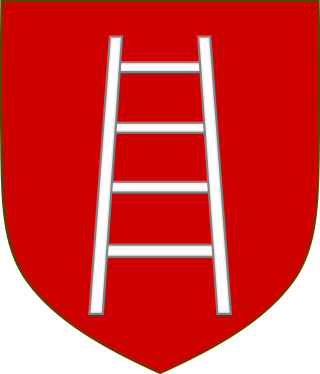
The House of Della Scala, whose members were known as Scaligeri or Scaligers, was the ruling family of Verona and mainland Veneto from 1262 to 1387, for a total of 125 years.

Cangrandedella Scala was an Italian nobleman, belonging to the della Scala family who ruled Verona from 1308 until 1387. Now perhaps best known as the leading patron of the poet Dante Alighieri, Cangrande was in his own day chiefly acclaimed as a successful warrior and autocrat. Between becoming sole ruler of Verona in 1311 and his death in 1329 he took control of several neighbouring cities, notably Vicenza, Padua and Treviso, and came to be regarded as the leader of the Ghibelline faction in northern Italy.

Villafranca di Verona is a town and comune in the province of Verona in the Veneto, Northern Italy.
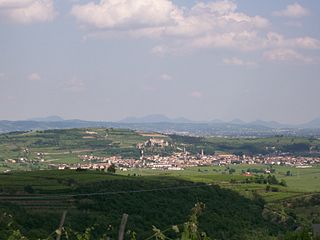
Soave is a small comune of the Veneto region in the Province of Verona, northern Italy, with a population of roughly 6,800 people.

Mastino I della Scala, born Leonardo or Leonardino, was an Italian condottiero, who founded the Scaliger house of Lords of Verona.

Alberto I della Scala was lord of Verona from 1277, a member of the Scaliger family.
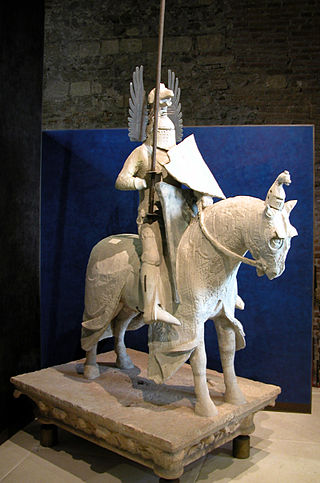
Mastino II della Scala was lord of Verona. He was a member of the famous Scaliger family of Northern Italy.

The March of Verona and Aquileia was a vast march of the Holy Roman Empire in the northeastern Italian Peninsula during the Middle Ages, centered on the cities of Verona and Aquileia. Seized by King Otto I of Germany in 952, it was held by the Dukes of Bavaria; from 976 in personal union with the Duchy of Carinthia. The margravial regime ended with the advent of the Lombard League in 1167.

Ubertino Ida Carrara, called Novello and better known as Ubertinello, was the Lord of Padua from 1338 until his death.

Cansignorio della Scala was Lord of Verona from 1359 until 1375, initially together with his brother Paolo Alboino.

Cangrande II della Scala was Lord of Verona from 1351 until his death.
Alboino I della Scala was the Scaliger Lord of Verona from 1304 until his death.

The Scaliger Tombs is a group of five Gothic funerary monuments in Verona, Italy, celebrating the Scaliger family, who ruled in Verona from the 13th to the late 14th century.
Paolo Alboino della Scala was a lord of Verona of the Scaliger dynasty.
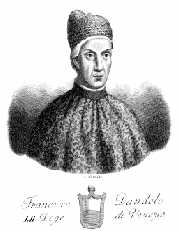
Francesco Dandolo was the 52nd Doge of Venice. He ruled from 1329 to 1339. During his reign Venice began its policy of extending its territory on the Italian mainland.
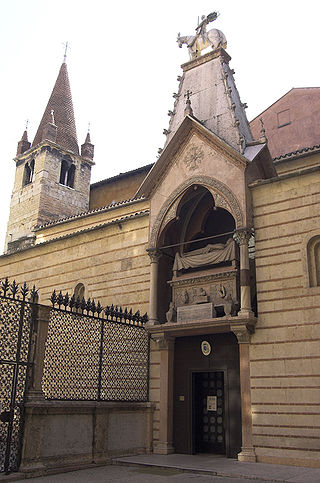
Santa Maria Antica is a Roman Catholic church in Verona, Italy. The current church is Romanesque in style and dates to 1185, rebuilt after the earthquake of 1117 destroyed the original building that dated back to the end of the period of Lombard domination in the 7th century. The only surviving remains of the 7th-century building is a fragment of black and white mosaic floor.
The following is a timeline of the history of the city of Verona in the Veneto region of Italy.
The Salt War was a brief war between Venice and Padua over salt works in 1304. Venice was victorious and its salt monopoly was confirmed.